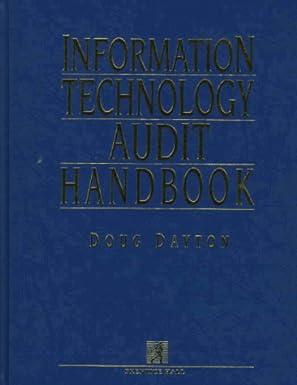
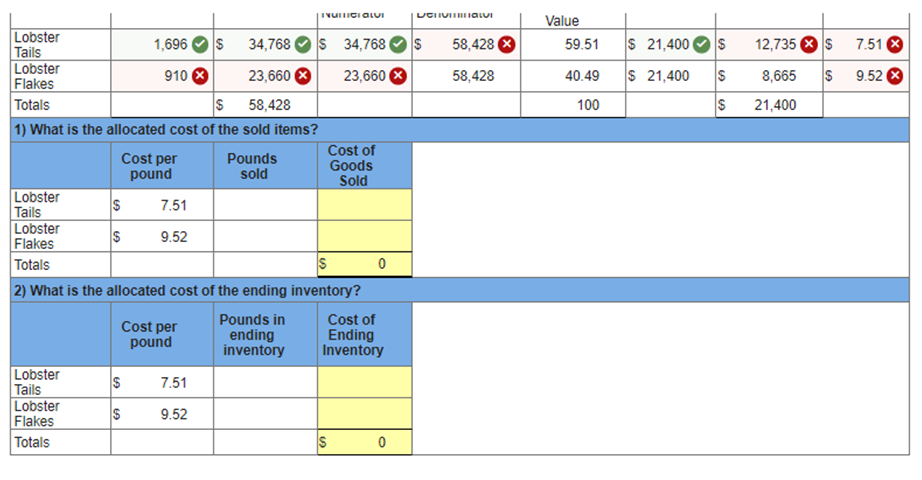
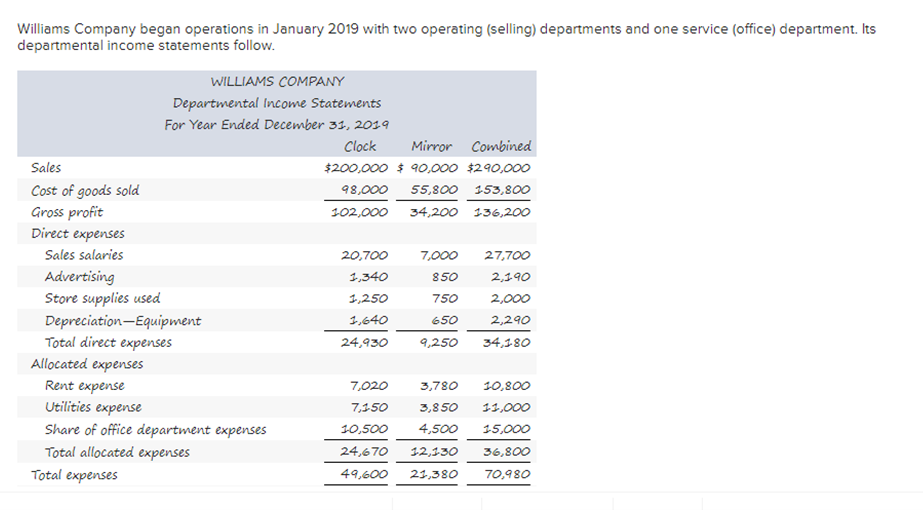
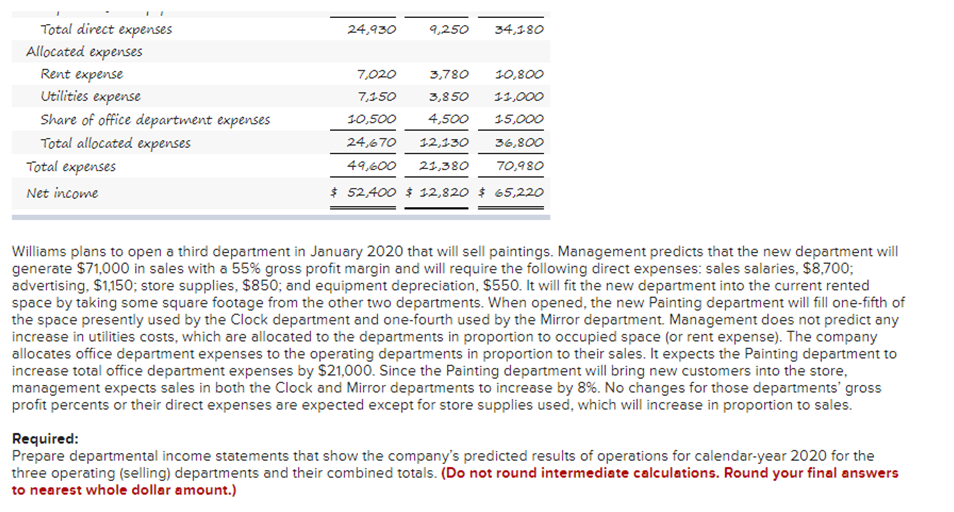
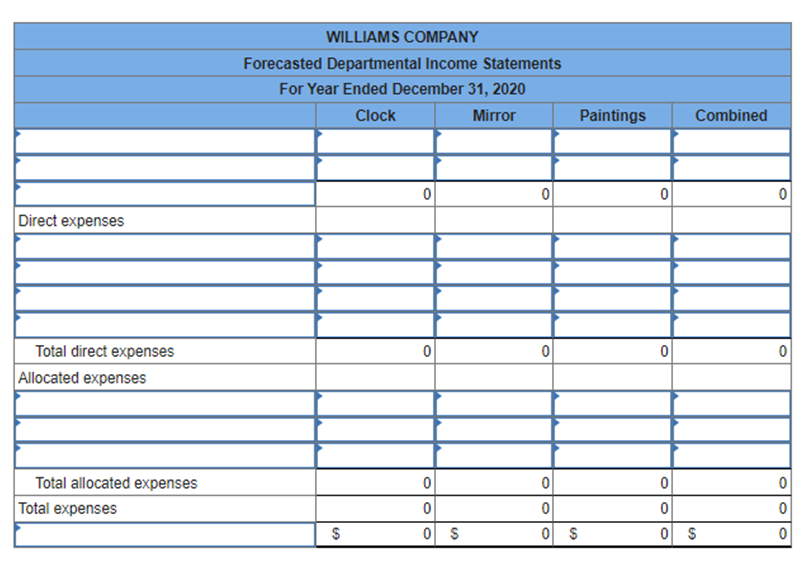
Pirate Seafood Company purchases lobsters and processes them into tails and flakes. It sells the lobster tails for $20.50 per pound and the flakes for $14.90 per pound. On average, 100 pounds of lobster are processed into 53 pounds of tails and 26 pounds of flakes, with 21 pounds of waste. Assume that the company purchased 3,200 pounds of lobster for $4 per pound and processed the lobsters with an additional labor cost of $8,600. No materials or labor costs are assigned to the waste. If 1,547 pounds of tails and 746 pounds of flakes are sold, calculate the allocated cost of the sold items and the allocated cost of the ending inventory. The company allocates joint costs on a value basis. (Round your answers to nearest whole number. Round cost per pound answers to 2 decimal places.) Answer is not complete. Cost to be allocated Allocated cost 3,200 pound purchase Cost per pound Yield per Market 3,200 lb. Value per 3,200 lb. Percent of Market Value purchase purchase Numerator Denominator % of Mkt Value Lobster 1,696 $ 34,768 $ 34,768 $ Tails 59.51 58,428 Lobster 910 23,660 23,660 58,428 40.49 Flakes Totals $ 58,428 100 1) What is the allocated cost of the sold items? Cost of Cost per Pounds Goods pound sold Sold Lobster 7.51 $ 21,400$ $ 21,400 $ s 12,735 $ 7.51 8,665 $ 9.52 % 21,400 Tails A Lobster IS 952 IVITICI ALUI UCHUHTALUI Value 59.51 $ 58,428 X $ 21,400 $ 7.51 X $ $ 58,428 40.49 $ 21,400 12,735 $ 8,665 $ 21,400 9.52 X 100 $ Lobster Tails 1,696 $ 34,768 $ 34,768 Lobster Flakes 910 23,660 23,660 Totals $ 58,428 1) What is the allocated cost of the sold items? Cost of Cost per Pounds Goods pound sold Sold Lobster Tails $ 7.51 Lobster $ Flakes 9.52 Totals s 0 2) What is the allocated cost of the ending inventory? Cost per Pounds in Cost of pound ending Ending inventory Inventory Lobster $ 7.51 Lobster Flakes $ 9.52 Totals s 0 Tails Williams Company began operations in January 2019 with two operating (selling) departments and one service (office) department. Its departmental income statements follow. WILLIAMS COMPANY Departmental income Statements For Year Ended December 31, 2019 Clock Mirror Combined Sales $200,000 $90,000 $290,000 Cost of goods sold 98,000 55,800 353,800 Gross profit 102,000 34,200 136,200 Direct expenses Sales salaries 20,700 7,000 27,700 Advertising 2,340 850 2,190 Store supplies used 1,250 750 2,000 Depreciation - Equipment 1,640 650 2,290 Total direct expenses 24,930 9,250 34,1-80 Allocated expenses Rent expense 7,020 3,780 30,800 Utilities expense 7,1-50 3,850 13,000 Share of office department expenses 10,500 4,500 25,000 Total allocated expenses 24,670 12,230 36,800 Total expenses 49,600 23,380 70,980 24,930 9,250 34,1-80 10,800 Total direct expenses Allocated expenses Rent expense Utilities expense Share of office department expenses Total allocated expenses Total expenses Net income 7,020 7,2-50 10,500 24,670 49,600 3,780 3,850 4,500 1-2,330 13,000 2-5,000 36,800 70,980 23,380 52,400 $ 12,820 $ 65,220 Williams plans to open a third department in January 2020 that will sell paintings. Management predicts that the new department will generate $71,000 in sales with a 55% gross profit margin and will require the following direct expenses: sales salaries, $8,700; advertising, $1,150; store supplies, $850; and equipment depreciation, $550. It will fit the new department into the current rented space by taking some square footage from the other two departments. When opened, the new Painting department will fill one-fifth of the space presently used by the Clock department and one-fourth used by the Mirror department Management does not predict any increase in utilities costs, which are allocated to the departments in proportion to occupied space for rent expense). The company allocates office department expenses to the operating departments in proportion to their sales. It expects the Painting department to increase total office department expenses by $21,000. Since the Painting department will bring new customers into the store, management expects sales in both the Clock and Mirror departments to increase by 8%. No changes for those departments' gross profit percents or their direct expenses are expected except for store supplies used, which will increase in proportion to sales. Required: Prepare departmental income statements that show the company's predicted results of operations for calendar-year 2020 for the three operating (selling) departments and their combined totals. (Do not round intermediate calculations. Round your final answers to nearest whole dollar amount.) WILLIAMS COMPANY Forecasted Departmental Income Statements For Year Ended December 31, 2020 Clock Mirror Paintings Combined 0 0 0 0 Direct expenses 0 0 0 Total direct expenses Allocated expenses 0 0 0 Total allocated expenses Total expenses 0 0 0 01 S 0 0 $ 0 01 S 0 0 0 $











